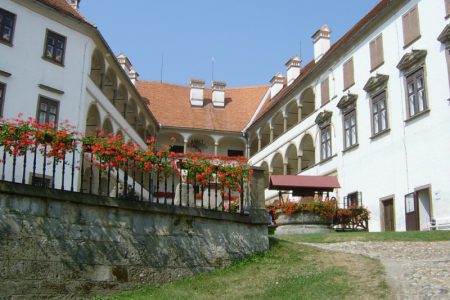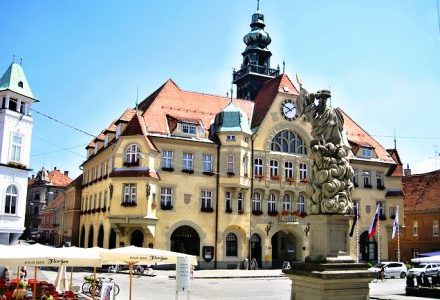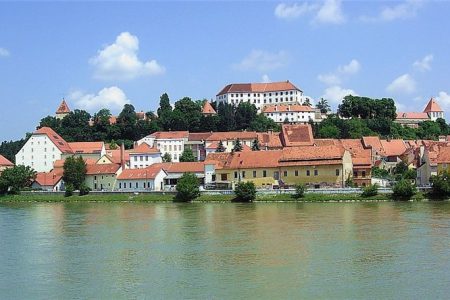Ptuj City Guide
Historic Ptuj (Pettau in German) has the distinction of being the oldest settlement in Slovenia and it’s a popular choice for day trips with tourists staying all over the country because its central location means it can be reached within a couple of hours from anywhere in Slovenia. To only drop in for a day, however, is to miss out on the beautiful surrounding countryside and the excellent leisure opportunities in south eastern Slovenia.
Today, Ptuj is a handsome walled town with an imposing castle, and a population of around 30,000. The river Drava flows past the old town, where it is dammed forming a lake which is visible from the castle ramparts. Over 7 kilometres long, Ptuj Lake is the largest artificial lake in Slovenia and forms part of the Šturmovci Nature Park. To the south the Haloze hills are an unspoilt haven ideal for walkers and nature lovers, while to the east the Jeruzalem-Ormož area, with its more gentle slopes, is wine country and popular with cyclists.
Ptuj was first settled over two thousand years ago. Under the Romans Poetovio was one of the most important towns in central Europe. They took advantage of the geographical position to build up a prosperous trading centre, a feature of Ptuj that was to last well into the middle ages; at that time Ptuj became famous for a number of fairs held throughout the year. Anyone wondering what the Romans did for Ptuj need only look at Terme Ptuj, one of Slovenia’s most popular thermal spa centres, and the vast vineyards which cling to the hills in the countryside surrounding the town.
The Romans, of course, were experts in treating themselves to some ‘me time’; Terme Ptuj continues that tradition, albeit with a greater degree of luxury. From the four starred Grand Hotel Primus to modern camping facilities and well maintained self catering cabins, Terme Ptuj offers a range of high quality holiday accommodation and entry to the thermal water park is included in the price. A wellness centre offering the latest pampering treatments, an eighteen hole golf course, and state of the art conference halls and meeting rooms are just some of the additional facilities on offer at the complex.
The history of viticulture in the region also goes back to Roman times but widespread cultivation of vines, especially in Haloze, started in the thirteenth century, under the careful eye of Minorite monks. Today the biggest and best preserved of Ptuj’s numerous wine cellars is the one beneath the old Minorite monastery. The best way for wine enthusiasts to enjoy what the area has to offer is to get out into the countryside to visit some of the wineries but visitors with limited time can take part in a wine tasting tour of Ptujska Klet which is located in the town centre.
Though Ptuj is a bustling contemporary town, its ancient traditions and its connections with the land are still enthusiastically observed. The biggest of those celebrations is ‘Kurentovanje’ which takes place each year around Shrove Sunday. Kurentovanje is the culmination of ‘Pust’, or ‘Carnival’, which is celebrated across central and western Europe but its origins do not go back as far as those of Pust. The origins of modern Kurentovanje can be traced back one hundred years or so when the men in rural communities would dress up in sinister looking costumes to chase away the last days of winter and to welcome in the spring; the origins of this lie somewhere in Slovene mythology. In 1960 it was decided to organise a more formal annual event to connect all the rural communities and their own Kurent traditions, and to prevent these traditions from disappearing. Today as many as 100,000 people come to Ptuj to join in the festivities over a ten day period; around 60,000 – 70,000 come to watch the main parades which take place on a Saturday and Sunday.
Nowadays women and children are among the kurenti but originally only men took part in the parade. A kurent wears a shaggy sheep skin costume and a monstrous mask; he carries a club with bells attached to it and rattles it to chase away winter as he passes through the villages. At the beginning of Kurentovanje the Prince of the Carnival is given control of the city for the duration of the festival. There are daily performances in front of Ptuj’s town hall during the day and in a carnival tent in the evenings. On the final day there’s a children’s parade and the burial of Carnival before power over the city is returned to the town’s mayor.
Visitors to Ptuj outside of Kurentovanje can see an exhibition of kurenti costumes and photographs of past parades in the regional museum housed in the town’s baroque castle. The museum is one of the best in the country and includes an interactive display of traditional musical instruments, a collection of glass paintings (a traditional folk craft) and, in the Representatives’ Hall, a colourful collection of seventeenth century portraits of Turkish and European military commanders, Ottoman ladies in fine robes and elegant headwear, and people from exotic countries in traditional dress. There is also a striking portrait of Siegmund Herberstein, the seventeenth century owner of Ptuj Castle, wearing a sumptuously embroidered silk coat given to him by Suleyman the Magnificent.
The Pokranjinski Muzej Ptuj-Ormož which administers the castle collection also oversees a number of other museums and archaeological sites. Among these are the castle museums at Ormož and Velika Nedelja and the Mihelič Gallery in Ptuj. France Mihelič was a Slovene artist who donated his all of his paintings and his wide ranging graphic collection to Ptuj Museums; the gallery is housed in a handsome old defensive tower beside the Drava in the town centre.
The collection also includes a number of important archaeological finds: there are the sculptures and inscribed stones found in several nearby locations that have been identified as Roman shrines to the god Mithras, and the Povoden Museum which is an open air lapidary named after Simon Povoden, the nineteenth century curate who found the relics. The most important find is the Orpheus Monument which can be seen in front of the town’s Gothic tower; this five metres high carved stone shows Orpheus playing his lyre as he mourns the loss of Eurydice.
The pilgrimage church of St. Mary at nearby Ptujska Gora is one of Slovenia’s most striking monuments. The church occupies an elevated position on a hill known as Black Mountain; the name comes from a story that says that Mary protected the church from invading Turks by sending a black cloud over the village of Ptujska Gora. The church contains a fabulous treasury of Gothic sculptures.
The beautiful surrounding countryside is as good a reason to visit Ptuj as the wealth of cultural treasures in this attractive town. There are over fifty kilometres of wine roads to explore in the Haloze and Slovenske Gorice regions as well as traditional villages with a slower pace of life. Storks’ nests are a common feature and the hedgerows are packed with wildlife. Ormož Jezero is an important nature reserve which attracts legions of ornithologists who come to see migrating birds stop off on their journey south for the winter, while the town’s castle boasts an impressive arboretum of exotic tree species.
Access to international airports in Ljubljana, Graz, Zagreb and Croatian Istria is good and the region has useful road connections into Croatia, Hungary and Austria as well as to the rest of Slovenia. Though Ptuj is relatively unknown outside Slovenia, it is increasingly becoming known as a centre for conferences and conventions and attracts thousands of visitors annually. International arts festivals such as the Days of Poetry and Wine, which made Ptuj its permanent home in 2010, also attract lots of visitors.
Though it has the feeling of a small town, Ptuj has all the modern shopping, entertainment and sporting facilities you would expect but the old town has been left unspoilt and new commercial developments have been confined to the outskirts of the town. Among the most popular properties with foreign buyers looking for a holiday home are the traditional Prekmurje farmhouses; these L-shaped cottages were originally divided into living quarters and animal stabling but many have been modernised to make comfortable contemporary homes. Un-renovated properties can still be found for sale and make a good investment, particularly for people who are looking for a property to convert into a holiday let. Alternatively there are modern family homes and luxury villas; new builds range from stunning contemporary residences to traditional style log cabins with all mod cons.
East of Ptuj the relatively flat landscape and friendly villages tend to attract older people while Haloze to the south has tiny settlements, ideal for those looking for seclusion but wherever one chooses Ptuj is a great place to live. With good schools, public services and shopping facilities as well as wonderful countryside, Ptuj offers an interesting alternative to the more usual ex-pat hotspots in the western part of Slovenia.
A charming city and you can view the best Ptuj Property on this site. In terms of real estate in Slovenia, we cover all areas and and if you have a specific request in terms of the area and the type of property you need – please contact us and we will be delighted to help.














